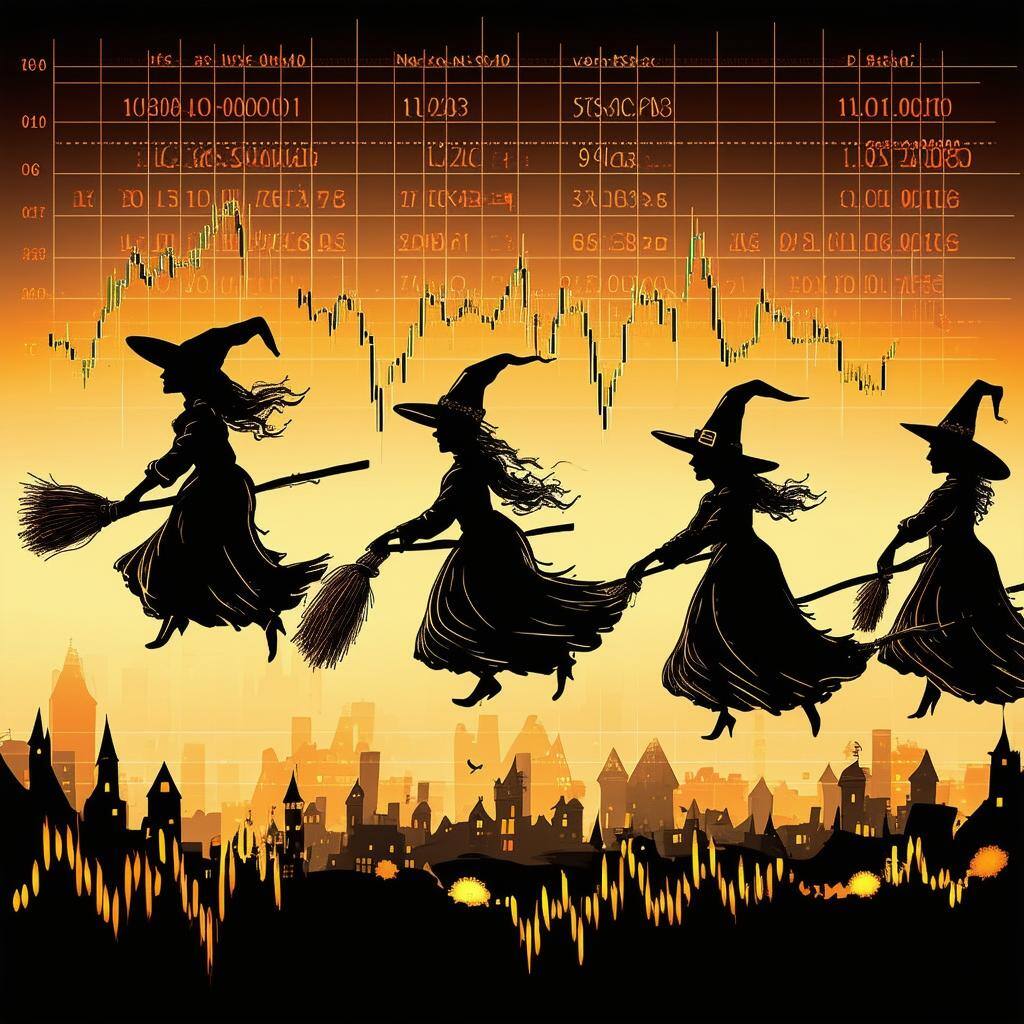
Stocks had a mixed close in bouncy trading session on Friday with moves exacerbated by options expiration. The first of the Fed speakers came out to justify its big cut and the one FOMC member that voted for a smaller cut warned that it was premature.
Falling. Ok, let’s just get it out of the way… it is autumn, otherwise known as fall. Are you surprised? I am not. For some strange reason, the trees in my garden began to signal the oncoming equinox with a blush a few weeks ago. I don’t blame them, it was a long, hot summer and they are entitled to their slumber. Well, it’s late-ish September, and if you were paying attention to Friday’s market action - I mean close attention - you might have noticed that it was rather wild. If you looked closer yet, you may have even noticed that volume was high… like, really high. Did you think that it might have been some sort of option expiration day?
Here is a question for you. What is worse than one witch? Four witches, of course. Friday was one of those so-called quadruple witching Fridays on which stock options, stock index options, stock index futures, and single-stock futures all expire. This happens on the 3rd Friday of March, June, September, and December. Volume on these days is typically abnormally large as options and futures holders shuffle to close out unwanted positions or extend them beyond expiration. On those days we can also see high volatility… sometimes. That “sometimes” is based on lots of things, but it is primarily driven by the market’s behavior in the month leading up to expiration. If that was volatile, you can usually anticipate volatility on expiration day, and I don’t know if you noticed, but things have been pretty volatile over these past few weeks, so Friday’s markets action shouldn’t be too surprising.
To illustrate this, let’s take a quick look at a popular stock that all of us either own, have owned, or wish we owned, Apple. Come on, admit that most of you at least have Apple in your stock watch list on your smartphones, even if you don’t know how it got there 😉. Well, if you were watching on Friday, you may have noticed that Apple dropped like a big rock in the final minutes of trade. Actually, big rocks fall at the same velocity as small rocks (in a vacuum)… but I digress. Anyway, Apple fell, check out this chart and follow me for a possible explanation… and maybe just one more chart.

Check out those last few minutes of trading. If you owned the stock, you were excited… until you weren’t. You probably rubbed your eyes to make sure you were seeing things right. First, lets be clear, the stock only fell like -2%, but it did go from being a good day to a bad one pretty quickly, which probably left many stunned. Let’s just say it was… noteworthy. So how can this be explained?
Well, let’s first recall that Apple is the largest company on America’s large cap index. I guess that makes it… um, large. Lots of people trade it, big and small. Traders sometimes prefer to use options to speculate on a position. A trader will buy a call option if they are counting on a stock going higher. The option gives the holder the right to purchase the stock at a given price at any time until the option expires (generally speaking, in an American style option). The price of the option therefore (also generally speaking) will go higher as the stock itself goes higher. The option holder can sell an option prior to expiration, and if the price is higher than when the holder purchased it, they will, naturally, make a trading profit. The holder can also exercise the option, which they are likely to do only if it is in the money, meaning, the strike price is below the market price. You wouldn’t like to buy a security above where the market is trading… I hope. If the call option owner holds the option to maturity, it will automatically be exercised if it is in the money. That means, the option holder will suddenly have to purchase the underlying stock at the option strike price. Because the option was in the money, the holder would own (after buying) the stock at a profit, below the market. Now what? Well, if the owner bought the option to speculate, they can simply sell the stock at the market and realize a profit, or they can hold the stock in anticipation of further gains. Now, let’s take a look at another chart. This one is also of Apple, but rather than an intraday chart, we will look back 3 months to get a clue what investors might have been thinking. Check it out, then follow me to the finish, finally.

You can see that Apple rallied from spring through mid-summer, peaking in mid-July at 234. Since then, it has been a rocky, sideways road. After getting as low as 207, the stock got some wind in its sails, climbing, but unable to get back up to and challenge its July high, only peaking at around 230 and pulling back, creating a resistance level. It is likely that at some point after the stock recovered from its August swoon, traders believed that it could come back, challenge the old high, and continue on its earlier positive trend. To do that, traders could have purchased call options. Early September saw the stock soften a bit, perhaps a good time to buy some more options. The Fed’s rate cut last week saw a solid 2-day rally for tech stocks, which included Apple. Things were looking up for those call option speculators. Would the stocks break through that resistance at 230? If so, the breakout could have seen the stock rally further. By late in the session, stock traders seemed to lose hope of a strong close above 230. Remember if those options holders held through the close, they would have to buy the stock at some point below the market. They had to decide if they wanted to own the stock at the strike price. By looking at the intraday chart, it looks like many traders sold the stock just before the closing bell. This would lock in any profit between where their options strike price was and the sale price of the stock. All that selling in anticipation of being exercised caused the stock to go down in the minutes prior to the bell. Therefore, a key takeaway is that some options holders did not want to own the stock beyond Friday and were happy to realize whatever profits were already on the table. NOW, to be clear, this is not the only explanation. For example, some may have chosen to sell to avoid having to finance the purchase of the stock and took pure profits off the table. There are indeed many more explanations… some even having nothing to do with the four witches that flew last Friday, but rest assure spells were cast on some traders. Finally, it is important to note that options are complicated and can be risky, make sure you understand them fully before you get involved.
FRIDAY’S MARKETS

NEXT UP
- S&P Global Flash US Manufacturing PMI (Sept) may have climbed to 48.6 from 47.9. Still below 50 is considered negative for the economy.
- S&P Global Flash US Services PMI (Sept) is expected to have slipped to 55.2 from 55.7.
- Chicago Fed National Activity Index (Aug) probably gained to -0.20 from -0.34.
- Fed speakers today: Bostic, Kashkari, and Goolsbee.
- Later in the week: we have some important earnings announcements, more housing numbers, Consumer Confidence, GDP, Durable Goods Orders, Personal Income, Personal Spending, and PCE Deflator. Download the attached calendars for earnings and economic release details.
DOWNLOAD MY DAILY CHARTBOOK HERE📊
.png)

